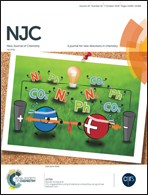Supramolecular inter-ionic charge-transfer complexes between derivatives of pyridinium-4-oxime cations and hexacyanoferrate(ii) anions†
Abstract
Mono- and bis-pyridinium-4-oxime compounds are introduced as new electron acceptors for the formation of colored, supramolecular, inter-ionic charge-transfer complexes with hexacyanoferrate(II) as a donor. The structure and properties of the formed complexes are characterized by a combination of experimental and computational studies. In water, the electron-donor/acceptor dyads exhibit a characteristic charge-transfer band in the visible spectral region whose energy is closely related to the acceptor's electron affinity, LUMO orbital energy and one-electron reduction potential. Such influence of the acceptor's electrochemical nature is revealed through varying the group attached to the N atom of the pyridinium-4-oxime moiety. The color, composition and spectroscopic analysis of the complexes in the solid state provide insights into binding of the cationic and anionic counterparts and the role of lattice water. Crystal structures are reported for two mono-pyridinium-4-oxime/hexacyanoferrate(II) complexes, characterized in solution by UV/Vis and 1H-NMR spectroscopy. Comparison of the solid-state structures and the aqueous-phase dyads reveals the nature of the charge-transfer interactions involving conjugated pyridinium-4-oximes as electron acceptors.



 Please wait while we load your content...
Please wait while we load your content...